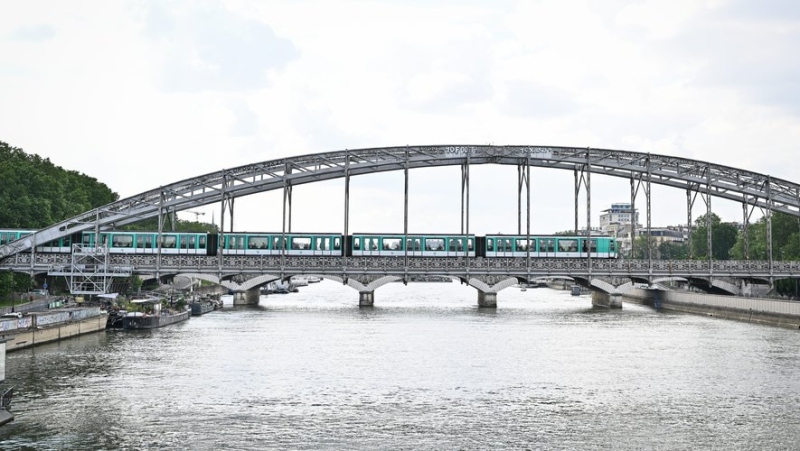Paris 2024 Olympic Games: ghost stations, art deco style, academics' revolt… five things to know about the Paris metro

Le métro parisien fourmille de mille et une anecdotes MAXPPP – Pierrick DELOBELLE
Cinq choses à savoir sur le métro parisien Paris, 24 juin 2024 (AFP) –
Monday's inauguration of the extension of line 14 of the Paris metro comes nearly 125 years after the launch of its first line in 1900. Here are five things to know about the metro: –< /p>
Denser than London or New York
The 14 lines of the Paris metro constitute a network of 256 km, dotted with 320 stations, according to data provided by the RATP. That's on average one station every 800 meters, making it one of the densest metropolitan networks in the world.
In comparison, the "Tube" London are 1.5 km apart on average, those of the "Subway" New York of 920 meters. Some 1.4 billion metro journeys were counted in 2023 by the RATP, or 3.8 million per day. Line 1, which crosses Paris from east to west via the Champs-Elysées and the Louvre, is the busiest, with 455,000 daily trips, ahead of line 4 (415,000) and line 9 (360 000).
Ghost Stations
The most attentive metro users have noticed, at the bend of a tunnel, disused platforms. The Paris metro has around ten ghost stations. Some have never been put into service, like Haxo or Porte Molitor.
Others were closed at the start of the Second World War and no longer operated since, because they were not profitable enough. This is the case for the Porte des Lilas stations (twin of a station still in service), Red Cross, Champs de Mars, Saint-Martin and Arsenal. Finally, some stations were moved, such as Gare du Nord or Porte Maillot, abandoning their old platforms.
Today, these stations serve as garages, technical rooms, testing and training tracks, or even filming sets. The Red Cross station was reused in 1983 to accommodate a beach and in 2007 for an exhibition by the National Library of France (BNF).
The Saint-Martin station is used by the Salvation Army day center. The disused Porte des Lilas station has served as the setting for numerous films, such as "The Fabulous Destiny of Amélie Poulain" (2001) or "A Wonderful Time" (1991).
Symbol of Art Nouveau
They are a symbol of Paris: the Art Nouveau entrances to the metro entrances, all made of green cast iron, were created by the architect Hector Guimard. Very fashionable in 1900 when the metropolitan was born, they quickly fell out of fashion. A few years later, "Guimard suffered a hate campaign: the green color of its metro entrances was compared to that of German uniforms, its tortuous buildings seemed to come from " from the depths of the Apocalypse, its candelabra are “strange lampposts, a sort of arms erected on cast iron tails holding between their hooks glass fruits in the shape of half-sucked cartons” ;", recalls the Paris City Hall website.
Of the 167 original structures, only 88 remain, including only two buildings, at the Abbesses and Porte Dauphine stations.
Academicians hijack line 4
At the beginning of the 20th century, the construction of line 4 on the north-south axis encountered fierce opposition from academicians, an episode recounted by researchers Yoann Brault and Baptiste Essevaz-Roulet in the bulletin of the Society of the History of Paris and Ile-de-France published in 2007.
The initial route requires the demolition of annexed buildings of the Institut de France. The academicians, who wanted the municipality to take care of the reconstruction of their annexes, opened hostilities in 1902.
They solicit Pierre Waldeck-Rousseau, President of the Council, and lead an intense press campaign. The opponents of the project have sometimes far-fetched arguments, such as "the passage of the metro under the dome" or its "purring" which could "disturb the work of the academics".
The academics obtain that line 4 adopts its "serpentine" route bypassing the Institut de France, inflicting a setback on “certain engineers suffering from a too dangerous “Haussmannitis””, in reference to Baron Haussmann, prefect of Paris who redesigned the capital in the 19th century by building wide straight avenues.
Crossing the Seine
This new route is turning into a headache for metro engineers. The passage from the left bank to the right bank of the Seine, initially planned for a short section of about 150 meters, was ultimately to be oblique and pass under the Île de la Cité.
A huge challenge for the engineers of the time, who opted for a technique never before used on this scale. The tunnel was built with prefabricated caissons sunk vertically, placed end to end in a trench dug in the river bed. The first caisson was placed in 1905, and the first passengers crossed the Seine five years later, in 1910.




